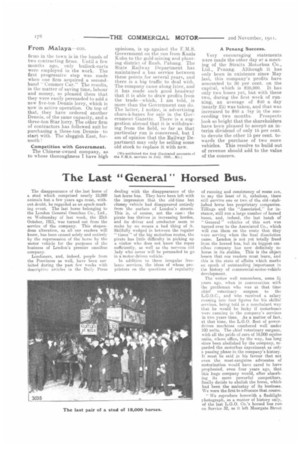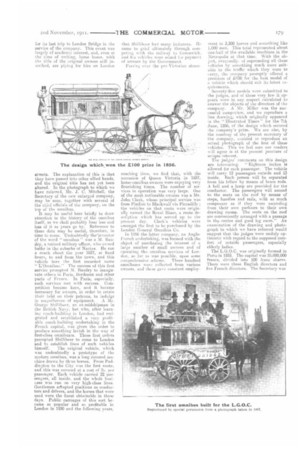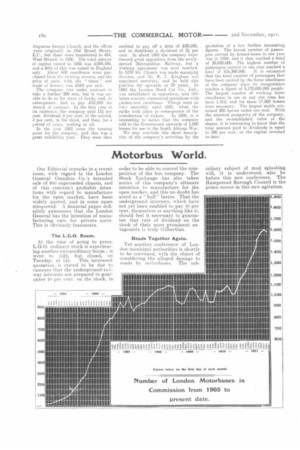The Last " General " Horsed Bus.
Page 6

Page 7

Page 8

If you've noticed an error in this article please click here to report it so we can fix it.
The disappearance of the Jest horse of a stud which comprised nearly 18,000 animals but a few years ago must, without doubt, be regarded as an epoch-marking event. The last horse belonging to the London General Omnibus Co., Ltd., on Wednesday of last week, the 25th October, 1911, was turned out from the service of the company. This stupendous alteration, as all our readers will know, has been caused solely and entirely by the supersession of the horse by the motor vehicle for the purposes of the business of London's premier omnibus company. Londoners, and, indeed, people from the Provinces as well, have been surfeited during the past few weeks with descriptive articles in the Daily Press
dealing with the disappearance of the last horse bus, They have been left with the impression that the old-time but clumsy vehicle had disappeared entirely from the surface of London's streets. 'This is, of course, not the case: the pirate bus thrives in increasing hordes, and its driver and conductor seem to make by no means a bad thing of itSkilfully wedged in between the regular " times " of the big motorbus routes, the pirate has little difficulty in picking up a visitor who does not know the ropes sufficiently, as well as the nervous old lady who never will be persuaded to go in a motor-driven vehicle.
In addition to these irregular freelance services, the ideas of whose proprietors an the questions of regularity
of running and consistency of route a re , to say the least of it, nebulous, there still survive one or two of the old-established horse bus proprietary companies. Tillings and the "Associated," for instance, still run a large number of horsed buses, and, indeed, the last batch of " General " vehicles of this sort was turned over to the Associated Co., which will run them on the route that they were serving when the final dissolution came. London is not yet totally freed from the horsed bus, but its biggest omnibus company has now definitely no horse in its stables. This is the object. lesson that our readers must learn, and this is the state of affairs which marks an epoch of outstanding importance in the history of commercial-motor-vehicle development.
The writer well remembers, some 4 years ago, when in conversation with the gentleman who was at that time chief veterinary surgeon to the L.G.O.C., and who received a salary running into four figures for his skilful services, being told in a nonchalant way that he would be lucky if motorbuses were i unning in the company's services in two years time. As a matter of fset,. at that time, the L.G.O. fleet of powerdriven machines numbered well under 100 units. The chief veterinary surgeon, with all the pride of care of 18,000 equineunits, whose office, by the way, has long since been abolished by the company, regarded the motorbus experiment as only a passing phase in the company's history. It must be said in his favour that not even the most-sanguine advocates of motorization would have cared to haveprophesied, even four years ago, that this huge company would, after absorbing its more powerful competitors, finally decide to abolish the horse, which had 'been the mainstay of its business.. We were the first to advocate that course.
" We reproduce herewith a flashlight photograph, as a matter of history only, of the last L.G.O. Co.'s horsed bus run on Service 32, as it left Moorgate Street.
for its last trip to London Bridge in the service of the company. This event was largely of academic interest, and, even at the time of writing, horse buses, with the title of the original owners still inscribed, are plying for hire on London streets. The explanation of this is that they have passed into other allied hands, and the original title has not yet been altered. In the photograph to which we have referred, Mr. 3. C. Mitchell, the Secretary of the new enlarged company, may be seen, logether with several of the chief officials of the company, on the top of the omnibus.
It may be useful here briefly to draw attention to the history of the omnibus itself, as we shall probably hear less and less of it as years go lay. Reference to these data may be useful, therefore, in time to come. Undoubtedly the...inventor of the word " omnibus " was a M. Bandry, a retired military officer, who owned baths in the suburbs of Nantes. He ran a coach about the year 1827, at fixed hours, to and from the town, and this vehicle bore the first recorded name " L'Ornnibus." The success of this first service prompted M. Baudry to inaugurate others in Paris, Bordeaux and other parts of France. In Paris, especially, such services met with success. Competition became keen, and it became necessary for owners, in order to retain their hold on their patrons, to indulge in magnificence of equipment. A Mr. George Shillibesm, an ex-midshipman in the British Navy, but who, after learning coach-building in London, had emigrated and established a very profitable coach-building undertaking in the French capital, was given the. order to produce something lavish in the way of first-class omnibuses. These first orders prompted Shillibeer to come to London and to establish lines of such vehicles
himself. The original vehicle, which was undoubtedly a prototype of the modern omnibus, was a long covered machine drawn by three horses. From Paddington to the City was the first. route. and this was covered at a cost of 2s. per passenger. Each vehicle carried 22 Passengers, all inside, and the whole business was run on very high-class lines. Gentlemen actepted positions as conductors and drivers, and the horses that were used were the finest obtainable in those days. Public carriages of this sort became so popular and so profitable in London in 1830 and the following years:
that Shilhher hart many imitators. He came to grief ultimately through competing with the railway to Greenwich. and his vehicles were seized for payment of arrears by the Government.
Passing over the pre-Victorien steam
coaching time, we find that, with the accession of Queen Victoria in 1837, horse-omnibus owners were enjoying very flourishing times. The number of services in operation was very large. One of the most noticeable owners was a Mr. John Clark, whose principal service was from Pimlico to Blackwall via Piccadilly the vehicles on that route were originally named the Royal Blues, a route description which has served up to the present day. Clark's vehicles were amongst the first to be purchased by the London General Omnibus Co.
In 18,56 the latter company, an Anglo
ench undertaking, was formed with the object of purchasing the interest of a large number of small owners and of operating thi; omnibus services of London. so far as was possible. upon some comprehensive scheme. Three hundred omnibuses wew collected from various owners, and these gave constant, employ
ment to 3,500 horses and something like 1,000 men. This total represented about one-half of the available machines in the Metropolis at that time, With the ohjest, eventually. of superseding all these vehicles by something much more suitable to the traffic which they were to carry, the company promptly offered a premium of £100 for the best model of a vehicle which should suit its latest requirements.
Seventy-five models were submitted to the judges, and of these very few it appears were in any respect calculated to answer the objects of the directors of the company. A Mr. Miller was the successful competitor, and we reproduce a line drawing, which originally appeared in. the 'illustrated Times " for the 7th June, 1856, of the design which secured the company's prize. We are also, by the courtesy of the present secretary of the company, enabled to reproduce an actual photograph of the first of these vehicles. This we feel sure our readers will agree is at the present juncture of antique interest.
The judges' comments on this design are interesting. " Eighteen inches is allowed for each passenger. The vehicle will carry 12 passengers outside and 13 inside. Each person will be separated from his fellow by means of brass rods. A bell and a lamp are provided for the conductor. The passengers will ascend to the seats on the roof by means of steps, handles and rails, with as much composure as if they were ascending from their own parlours to their own drawing rooms. The seats on the roof are conveniently arranged with a passage in the centre and good leg room." An examination of the drawing and photograph to which we have referred would suggest that the judges were unduly optimistic with regard to the supposed comfort of outside passengers, especially elderly ladies. The L.G.O.C. was originally formed in Paris in 1855. The capital was 25,000,000 francs, divided into 100 franc. shares. There were three English directors and five French directors. The Secretary was Augustus George Church, and the offices were originally in Old Broad Street, E.C., but these were transferred to 454, West Strand. in 1856. The total amount of capital raised in 1856 was £594,100, and a fifth. of this was raised in England only. About 600 omnibuses were purchased from the existing owners, and the price of each, with the " times " and studs of herses, was £666 per unit. The company was under contract to take a further 200 sets, but it was unable to do so for want of funds, and, in consequence, had to pay £25,000 for breach of contract. In the first year of its existence, the company paid 12i per cent. dividend, 8 per cent. in the second, 3 per cent, in the third, and then, for a period of years, nothing at all. In the year 1862 came the turning point for the compan, and this was a great exhibition year. They were then enabled to pay off a debt of £30,000, and to distribute a dividend of 3f per cent. In about 1863 the company experienced great opposition from the newlyopened Metropolitan Railway, but a working agreement was soon reached. In 1879 Mr. Church was made managing director, and Nfr. R. T. Kitigharn was appointed secretary, and he held this position for upwards of 30 years. In 1880 the London Road Car Co., Ltd., was established in opposition, and this latter concern commenced operations with garden-seat omnibuses. Things went on very smoothly until 1891, when the strike took place in consequence of the introduction of tickets. In 1900, it is interesting to notice that the company sold to the Government upwards of 1,000 horses for use in the South African War.
We may conclude this short description of the company's activities by the quotation of a few further interesting figures. The lowest number of passengers carried by horsed-buses in one year was in 1859, and it then reached a total of 39,000,000. The highest number of passengers carried in one year reached a total of 216,300,000. It is estimated that the total number of passengers that have been carried by the horse omnibuses of the company since its inauguration reaches a figure of 5,170,000,000 people. The largest number of working horse omnibuses in use at any one time has been 1,418, and for these 17,8130 horses were necessary. The largest stable contained 900 horses under one roof. With the renewed prosperity of the company, and the re-established value of the shares, it is interesting to know that the total amount paid in dividends is equal to 380 per cent, on the capital invested to date.




















